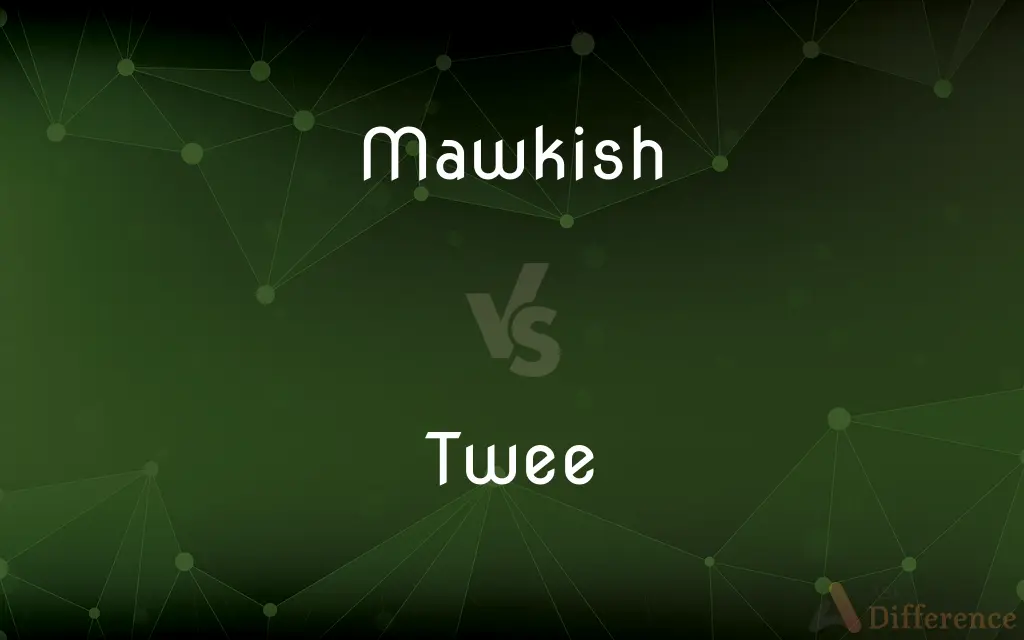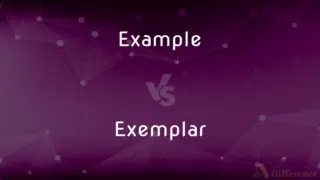Mawkish vs. Twee — What's the Difference?
Mawkish describes something excessively sentimental, often to the point of being cloying or sickening, while twee refers to affectedly quaint or overly dainty.

Difference Between Mawkish and Twee
Table of Contents
ADVERTISEMENT
Key Differences
Mawkish often implies an emotional excess that can become unappealing or distasteful, suggesting insincerity or superficiality in the expression of feelings. Twee, on the other hand, connotes a deliberate quaintness or cuteness that can appear excessively precious or contrived.
While mawkish is typically used to describe situations, literature, or art that tries too hard to evoke pity or sentimental feelings, twee is more commonly associated with style, fashion, or decor that is excessively neat, pretty, or sentimental in a somewhat artificial way.
Mawkishness can cause a negative reaction in the audience due to its overblown sentimentality, potentially leading to discomfort or annoyance. Conversely, something that is twee might be endearing to some, but to others, it can seem annoyingly affected and superficial.
In literature, a mawkish poem or story fails because its emotional appeal is viewed as ungenuine or manipulative. Whereas in the case of twee, the narrative or aesthetic might be criticized for its overemphasis on quaintness and charm, which can detract from substantive content.
Mawkish can be seen in expressions of love or grief that are perceived to be excessive or inauthentic. Twee, however, is often seen in the deliberate use of old-fashioned or nostalgic elements which are intended to invoke charm in an overly cutesy manner.
ADVERTISEMENT
Comparison Chart
Connotation
Overly sentimental, cloying
Excessively quaint, overly dainty
Common Usage
Emotional expressions, art
Style, fashion, decor
Audience Reaction
Often negative, seen as insincere
Can be divisive; endearing or irritating
Typical Context
Literature, film
Aesthetic choices, cultural artifacts
Implication of Use
Criticism of emotional manipulation
Criticism of artificial quaintness or cuteness
Compare with Definitions
Mawkish
Excessively sentimental.
The movie's mawkish dialogue made it difficult to take seriously.
Twee
Excessively dainty or delicate.
Her twee mannerisms did not fit the rugged setting.
Mawkish
Sickeningly emotional.
The novel had a mawkish tone that overshadowed its historical accuracy.
Twee
Intentionally old-fashioned for effect.
The party's theme was twee, complete with vintage teacups.
Mawkish
Overdone to the point of being repulsive.
The mawkish display of affection was too much for the audience.
Twee
Aimed at evoking a nostalgic charm.
The film used a twee soundtrack to capture the era.
Mawkish
Characterized by ungenuine emotions.
The play's mawkish sentiments did not resonate with the critics.
Twee
Overly precious in style or manner.
The boutique sold only the most twee accessories.
Mawkish
Tending to cause emotional discomfort.
His mawkish speech about loyalty felt contrived.
Twee
Affectedly cute or quaint.
The cafe's decor was so twee it felt like a movie set.
Mawkish
Excessively and objectionably sentimental.
Twee
Overly precious or nice.
Mawkish
(Archaic) Having a sickening taste.
Twee
Overly quaint, dainty, cute or nice.
Mawkish
Excessively or falsely sentimental; showing a sickly excess of sentiment.
Twee
Affectedly dainty or refined
Mawkish
Feeling sick, queasy.
Mawkish
(archaic) Sickening or insipid in taste or smell.
Mawkish
Apt to cause satiety or loathing; nauseous; slightly nauseating; disgusting.
So sweetly mawkish', and so smoothly dull.
Mawkish
Easily disgusted; squeamish; sentimentally fastidious.
Mawkish
Weakly sentimental; maudlin.
Mawkish
Effusively or insincerely emotional;
A bathetic novel
Maudlin expressons of sympathy
Mushy effusiveness
A schmaltzy song
Sentimental soap operas
Slushy poetry
Common Curiosities
What does mawkish mean in literature?
Mawkish in literature refers to overly sentimental writing that tries too hard to evoke emotional responses, often perceived as insincere.
Is mawkishness always negative?
Typically, yes, as it implies an excessive sentimentality that is seen as ungenuine or overdone.
Can a person be described as mawkish?
Yes, if their emotional expressions seem excessively sentimental or insincere, they can be described as mawkish.
How does twee differ from kitsch?
While both can involve nostalgia and excess, twee is more about quaintness and daintiness, whereas kitsch involves tackiness and garishness.
What is an example of mawkish behavior?
Publicly displaying excessive emotions in a way that feels forced or manipulative is mawkish behavior.
Is twee fashion popular?
Twee fashion has niche popularity, often embraced for its retro and quaint appeal.
Does mawkish have a positive use?
Rarely, as it is predominantly used to denote negative, over-the-top sentimentality.
What makes an artwork mawkish?
Artwork that overtly tries to provoke sentimental reactions without genuine depth can be considered mawkish.
How can a movie be twee?
A movie can be twee by adopting a style that is excessively quaint or charming, often in a way that feels artificially cutesy or precious.
What type of decor is considered twee?
Decor that is overly quaint, excessively dainty, or deliberately nostalgic can be considered twee.
How can I tell if something is too twee?
If it seems overly affected, excessively dainty, or trying too hard to be quaint, it may be too twee.
Why do people use twee aesthetics?
People often use twee aesthetics to evoke a sense of nostalgia, innocence, or charm in an overly deliberate way.
Can a book be both mawkish and twee?
Yes, a book can be both if it combines excessive sentimentality with an affectedly quaint style.
Are there cultural differences in what is considered twee?
Yes, cultural contexts can influence what is seen as quaint or overly dainty, affecting perceptions of twee.
Can mawkishness be effective in any context?
While generally seen as negative, mawkishness can sometimes effectively highlight certain themes or characters in stories.
Share Your Discovery

Previous Comparison
Example vs. Exemplar
Next Comparison
Colonnade vs. Portico













































